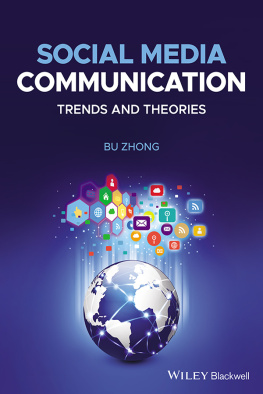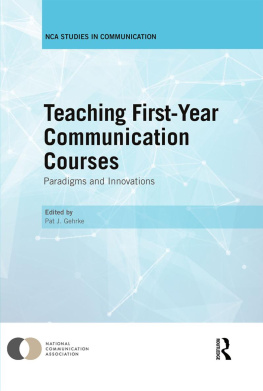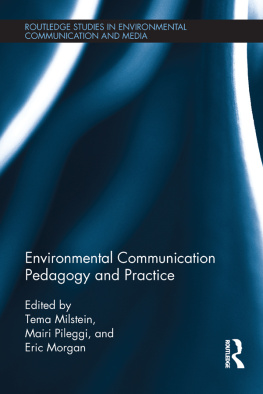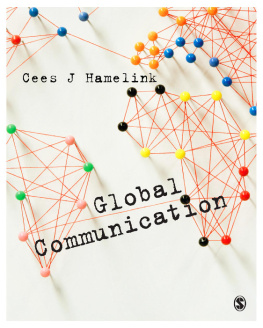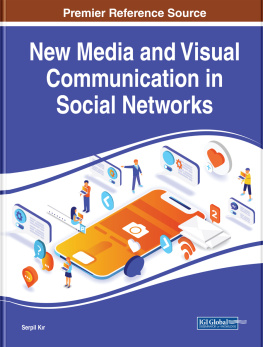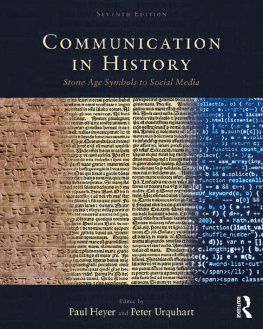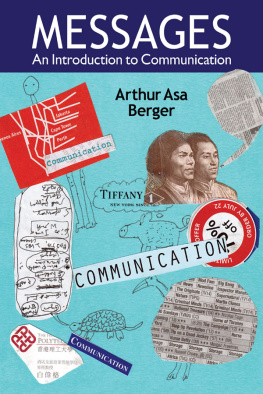First published 2015
by Routledge
711 Third Avenue, New York, NY 10017
and by Routledge
2 Park Square, Milton Park, Abingdon, Oxon OX14 4RN
Routledge is an imprint of the Taylor & Francis Group, an informa business
2015 Taylor & Francis
The right of Jan Fernback to be identified as author of this work has been asserted by her in accordance with sections 77 and 78 of the Copyright, Designs and Patents Act 1988.
All rights reserved. No part of this book may be reprinted or reproduced or utilized in any form or by any electronic, mechanical, or other means, now known or hereafter invented, including photocopying and recording, or in any information storage or retrieval system, without permission in writing from the publishers.
Trademark notice: Product or corporate names may be trademarks or registered trademarks, and are used only for identification and explanation without intent to infringe.
Library of Congress Cataloging in Publication Data
Fernback, Jan, 1964
Teaching communication and media studies : pedgagogy and practice / Jan Fernback.
pages cm
Includes bibliographical references and index.
1. Mass mediaStudy and teaching (Graduate) I. Title.
P91.3.F375 2015
302.20711dc23 2014027603
ISBN: 978-0-415-88663-5 (hbk)
ISBN: 978-0-415-88664-2 (pbk)
ISBN: 978-0-203-69448-0 (ebk)
Typeset in 10/12 Bembo
by codeMantra
Many thanks to my students who continually inspire and amaze me. I owe a great debt to colleagues who agreed to be interviewed or otherwise shared their wisdom. They are Kim Bissell, Bonnie Brennan, John Campbell, Terry Harpold, Jarice Hanson, Tom Johnson, Jack Klotz Jr., Matthew Lombard, Brian McFadden, Andrew Mendelson, Dustin Morrow, Adrienne Shaw, Maria Simone, William Walter, and Kristine Weatherston. I am particularly grateful to Nancy Morris whose invaluable feedback helped shape this book and my teaching. The many conversations weve had and work weve done together are woven throughout this book. Generous thanks to Erica Wetter at Routledge for her continued support. Lastly, my family and friends have encouraged and sustained me, particularly my husband, David Hollar. Thank you all.
TEACHING COMMUNICATION AND MEDIA STUDIES: INTRODUCTION
Media and communication educators, like the students they teach, understand the extent to which contemporary experience is mediated. The everyday environment is awash in mobile computers, smartphones, mp3 players, HD radio and television, online social networking, text messaging, microblogging, sundry digital applications, and myriad forms of print and video content. Since mediated communication envelops us, educators must engage with mediated communication in order to be relevant to and attentive to modern realities. As divisions between producers and audiences disintegrate, effective communication becomes increasingly crucial to contemporary living and working. Media and communication educators recognize that teaching about media, about communication, is a sometimes frustrating exercise in metacommunication. How does communication challenge yet create social tensions such as racism, homophobia, sexism, or ageism? How are media integrated into our psychological, sociocultural, political, economic, technological, and historical lives? These questions are addressed by media studies and communication studies as each field considers the communicative process, message content, symbolic meaning, and impact of message reception. Media and communication related fields in the academy are more relevant now than ever as university educators struggle with pedagogical issues of the daycritical thinking, facility with technology, relativistic epistemologythat are typically addressed in communication and related disciplines. The ubiquity of communication and media-related issues in our world illustrates the primacy of communication/media studies in any university students education.
Communication and media studies address structure, intent, content, and interpretation of all types of messages. All human action is grounded in communication. This is why it is essential to grasp the basics of all forms of communication. Communication is culture; it is part of a system of cultural practices that create, maintain, and transmute society. As James Carey (1989) and others have claimed, our minds and lives are shaped by our total experience (p. 33) or by symbols of experience; those symbols are communication. Our cultural realities are communicated through various means, including the media. We use stories of our culture to be entertained, to learn, to understand values, to grasp how society works. Ideally, audiences have a responsibility to question the storytellers and to reflect on the meanings of messages and what they say about culture. This book is about tying together the need to understand the ways and means of communication/media studies with pedagogies that strategically address media and communication topics. For reasons to be explained later in this introduction, the book uses the terms mediated communication and communication/media studies interchangeably. The term communication refers generally to mediated communication and not to rhetorical studies.
This book is written for a broad range of instructors in the academy: graduate students and faculty who teach media studies, communication, RTF (radio, television, film), journalism, American studies, anthropology, sociology, cultural studies, English, or other disciplines that engage with media as a content area. Thus, this book seeks to position the educator within the academy but outside rigid disciplinary boundaries. Graduate student teaching assistants as well as newer faculty and those who wish to revitalize their teaching or keep up with changing technological and social realities will find this book useful as they engage in the teaching of media-related content. The book accounts for broad approaches to media as means of communication between senders and receivers; as industries or organizations; as agents of social change and globalization; as agents of social stability and powerful sources of social meaning; as devices of surveillance; as commodities produced by media sub-industries; as cultural products with social, economic, historical, political, and technological significance.
Ideas about media are central to any pedagogical practice. Media-saturated environments make media studies a necessity, and communication education is an essential component of every students plan of study, according to Dickson (2000, p. 188). Morreale and Pearson (2008) find that education in communication is essential for both professional and personal success. Their analysis shows that knowledge of communication is crucial for holistic personal development, responsible involvement in activities of the citizenry, and addressing concerns of contemporary life. Kincheloe (2004) claims a vision of pedagogy that is grounded in social justice and includes a reconceptualization of education as it relates to community, marginalized groups, and the nature of knowledge (p. 6). To that list, I add how we live in the world as an essential educational axiom that acknowledges our media-inundated existence. As educators, we must formulate ideas about enacting our educational values into our pedagogical approaches. John Dewey said, [Education] has to do with the perpetuation of positive values of inherited culture by embodying them in the dispositions of individuals who are to transmit culture into the future (Brown, 1970, p. 53). Thus, faculty develop identities as both educators and as scholars. These identities sometimes fail to intersect as cleanly as we may like, for institutional realities sometimes dictate that one cannot always teach ones research. This book provides an opportunity for graduate student educators and faculty to contemplate our academic identities as it explores both the practical modalities of teaching and the philosophical presumptions about how/what/why we teach.


